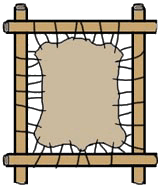Tanning Spirit Notes and Updates
-Smoking-

Leaving the hide white and soft is desirable if one is going to use it for ceremonial occasions, but for everyday functional use, smoking is advisable. Smoking forces tannic acid around the fibers. If the smoked skin gets wet, say in a rain storm, it will dry out slightly stiff. It can then be rubbed between your hands and softened. Therein lies the beauty of braintanned buckskin.
To smoke the hide, begin by folding it in half lengthwise, with the flesh side out and grain side in. At the bottom, from center, measure over 12 inches. Make a mark at that point. Either by hand or with a sewing machine, sew the hide together toward the neck. The seam doesn't need to be very wide; the hide won't tear out.
What you have now is a sock with a twelve-inch diameter opening at the bottom to which you'll attach a denim skirt made from a pair of old Levis. Cut off both denim legs to a length of 20 to 24 inches, and open the two inseams. Restitch the two pieces into a tube (12-inch diameter at the top, with the bottom flared enough to encircle a metal bucket). This skirt allows the hide to be placed above the hot coals and punky wood, away from any flames.
A metal fire bucket with nail-sized holes in and around the bottom edge will allow air into the coals. First place three small, golf-ball-sized rocks inside, then coals, be it charcoal or wood coals. Next place a metal dish on the three rocks. Put rotten wood on the plate to give the needed smoke. To prevent possible flare ups, drive three nails into the bucket, evenly spaced around it and about halfway up. Place a hub cap inside the bucket on the nails. This traps the smoke and cools it and collects some of the creosote.
Different types of wood will give varying colors to the hide. Golden buckskin is obtained from cottonwood or aspen; alder will be darker; fir and pine give dark color and also more creosote, making the hide tacky to the touch. It will take a few days airing out to get rid of the tackiness. Of course any wood will work, so find what is in your locality and give it a try.
Hang the hide directly over the smoking bucket from a quad-pod, high enough so that the hide is full length. Take 8 barbless fishing hooks, attach a piece of thread four or five feet long to each hook, and use the hooks to keep the hide billowed open. Do this by just barely catching the skin with the hooks and tie
them off to a pole.
Pull the skirt over the smoking bucket. Smoke will come out any holes in the hide that weren't sewn. Plug these with wads of newspaper. The advantage of plugged holes is that you can peek inside to check how the
color is coming along. If there aren't any holes in the hide, cut a 2-3 inch section of the sewn edge to look through.
Periodically check the color. If the smoke dies down, check the wood. Add more if needed. Occasionally take the metal plate out and discard the ashes and start over with new punk. Otherwise, if you continue
to add punky wood and don't discard the ashes, it will flame up or get too hot. You want the smoke to be cool, which gives the nice pretty colors. Excessively hot smoke results in an undesirable gray, burnt color.
Depending on the hide, smoke should start showing through the flanks and belly. The neck takes the longest to penetrate, but once the color is obtained, remove the hide immediately. Turn it inside out and repeat the process for the flesh side.
Remove the skirt, split the seam out, lay the hide grain side up, and roll it up. Put it away for a day or two to "set" the color. Unroll, trim off the edge, and leave two strands of buckskin on the rear corners to hang the hide up (folding the hide will cause creases).
A finished braintanned buckskin brings you to the most difficult part yet -- making the first cut with a pair of scissors!
New Notes on Smoking


New smoker: I no longer use the metal bucket for smoking. I used that method for over thirty years. The smoker that you see in the picture is a modification of a smoker that was made by Bob Kursawe, an excellent braintanner from Connecticut. The smoker is made of half-inch plywood; measurements are 12 x 16 x 13.5. The bottom is lined with fire brick, which allows the smoker to sit on any surface from bare ground to a wooden floor. All inside surfaces are lined with fireproof cement board. The black stack is an eight-inch stove pipe, ten inches high with an extension of a reducer that goes from 8 inch to 12 inches.

Want to make your own buckskin clothing?
Learn to tan hides, sew buckskin, and design your own clothing!
Check out the Hunter-Gatherer Immersion Program at Green University® LLC.
Return to BraintanBuckskin.com Home Page




 BraintanBuckskin.com
BraintanBuckskin.com









